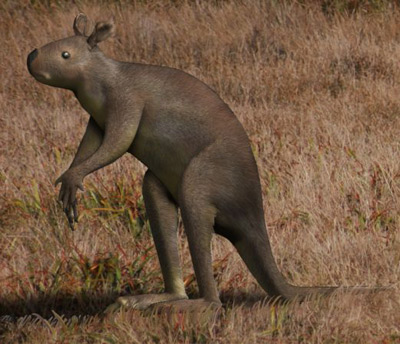
|
Search JoyZine with Google Site Search! |
Sthenurus
Sthenurus ("strong tail") is an extinct genus of kangaroo. With a length of about 3m, some species were twice as large as modern extant species. Sthenurus was related to the better-known Procoptodon. They had a tail shorter but stronger than present species of kangaroo, and only one toe instead of three, like the red kangaroo. At the end of the foot was a small, hoof-like nail suited for flat terrain; this toe is considered their fourth toe. Their skeletal structure was very robust with powerful hind limbs, broad pelvis, longer arms and phalanges than modern species and a short neck. Their phalangeal bones that make up their fingers may have been used to hold stems and twigs. These unique adaptations suited their feeding habits of browsing in the case of S. occidentalis, but other species were most likely grazers. They possessed a short, deep skull which was suited for eyes with stereoscopic vision, allowing for better vision. Their teeth were tough and strongly enameled, useful for tough vegetation, and with a striation pattern. Research by Darren R Gröcke from Monash University, analysed the diets of fauna at various fossil site localities in South Australia, using stable carbon isotope analysis 13C/12C of collagen. He found that at older localities like Cooper Creek the Sthenurus sp. was adapted to a diet of leaves and twigs (browsing). This was due to the wet climate of the time period between 132,000-108,000 years ago (thermoluminescence dating and uranium dating), which allowed for a more varied vegetation cover. At the Baldina Creek fossil site 30,000 years (carbon-14 dating), the genus had adapted to a diet of grasses (grazing). At this time the area was open grasslands with sparse tree cover as the continent was drier than today. But at Dempsey's Lake (36,000-25,000 years ago) and Rockey River (19,000 carbon-14 dating), their diet was of both grazing and browsing. This analysis may be because of a wetter climatic period. The overall anatomy of the genus did not evolve for the change in diet and dentition did not adapt to the varying toughness of the vegetation between grasses, shrubs and trees. From evidence gathered at Cuddie Springs, according to Judith Field and Richard Fullagerit, it is known that Indigenous Australians inhabited the same habitat as that of Sthenurus and various other extant and extinct species of animal. At this locality there seems to be a lack of any specific tools suitable for hunting. Instead there are tools used to cut meat off the bone, as there is blood residue left on the stone tools. Any material made of wood for hunting, such as the boomerang and spear, has either not survived intact or was not used by the people of the time in this locality. |
